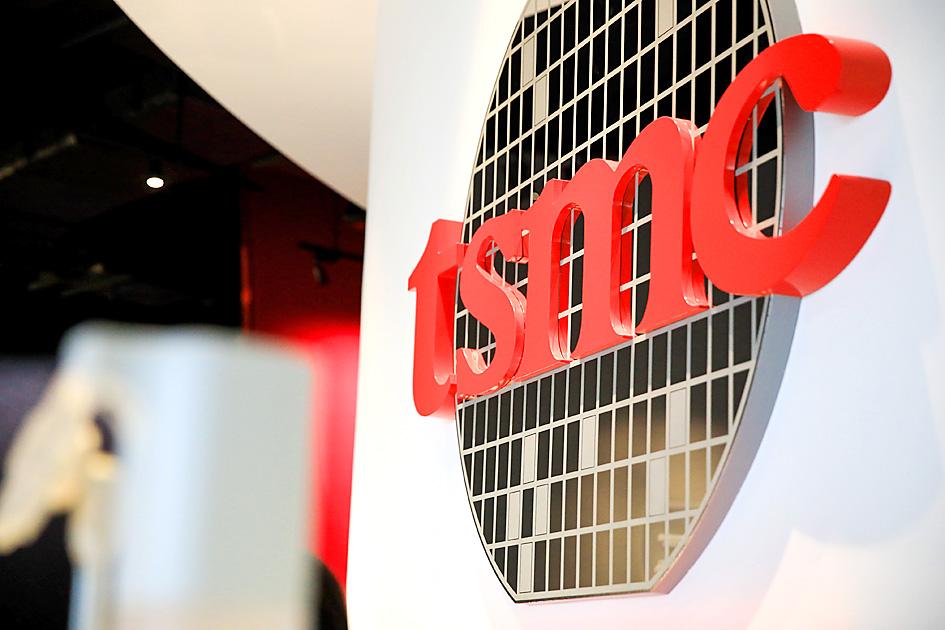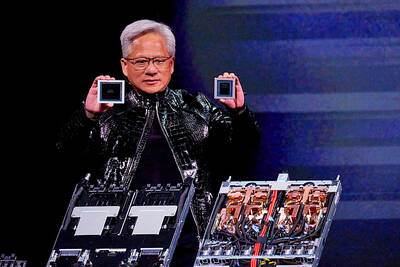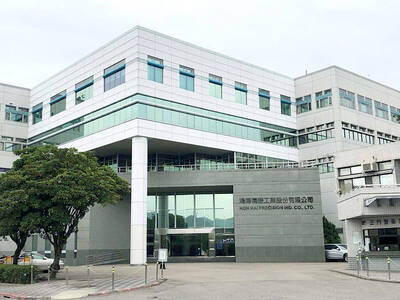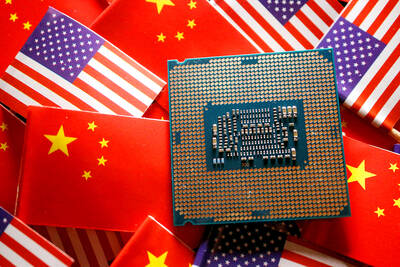Sales from Taiwan Semiconductor Manufacturing Co’s (TSMC, 台積電) largest customer grew to account for 26 percent of the chipmaker’s total revenue last year.
Although TSMC financial data did not specify the customer, analysts said they suspect it was Apple Inc.
TSMC’s largest customer contributed NT$405.4 billion (US$14.27 billion) to the chipmaker’s sales, up NT$68.63 billion or 20.37 percent from 2020.

Photo: I-Hwa Cheng, Bloomberg
That brought the largest customer’s share of TSMC’s sales to 26 percent, up from 25 percent a year earlier.
The data reinforced analysts’ suspicions that the customer is Apple, as revenue from its TSMC orders grew more than 20 percent from a year earlier.
TSMC’s consolidated revenue reached a record NT$1.587 trillion last year, up 18.53 percent from 2020, on the back of emerging technologies such as 5G and Internet of Things applications, high-performance computing devices and automotive electronics.
TSMC is believed to be the sole supplier of A-series processors for Apple’s iPhone line because of the chipmaker’s advanced 5-nanometer process, which is the latest technology the Taiwanese company has used for commercial production, analysts said.
Apple’s Mac and iPad lines have also used TSMC’s chips, analysts said.
Apple last week unveiled the M1 Ultra chip, which the company says is the next leap forward for its silicon program and the Mac.
Analysts said that TSMC is expected to benefit from the debut of the M1 Ultra chip this year.
Last year, TSMC’s second-largest customer contributed NT$153.74 billion to its sales, accounting for 10 percent of the chipmaker’s total, company data showed.
Analysts said they suspect the customer was Advanced Micro Devices Inc (AMD).
TSMC’s data indicated it was the first time sales from its second-largest customer rose to 10 percent of its total sales.
The US market was the largest buyer of TSMC’s chips last year, generating NT$1.01 trillion in sales, up 24 percent from a year earlier, and making up 64 percent of the chipmaker’s total.
That was followed by Taiwan, where the company generated NT$203.96 billion in sales, a 58 percent increase from a year earlier and accounting for 12.8 percent of TSMC’s total sales.
China was third, generating NT$164.55 billion in sales, down 29.6 percent from a year earlier and representing 10.3 percent of the chipmaker’s total sales, TSMC’s data showed.
Analysts said the decline in sales to China largely reflected Washington’s sanctions against Huawei Technologies Co (華為), which led to TSMC halting shipments to the Chinese firm.
TSMC said its 7-nanometer process created NT$440.38 billion in sales last year, up 11.5 percent from a year earlier, while the 5-nanometer process registered NT$262.33 billion in sales, up 188 percent from a year earlier. The technologies were the major sources of sales for TSMC.
TSMC is developing the more sophisticated 3 and 2-nanometer processes, and it is set to start mass production using 3-nanometer technology in the second half of the year.

Nvidia Corp chief executive officer Jensen Huang (黃仁勳) on Monday introduced the company’s latest supercomputer platform, featuring six new chips made by Taiwan Semiconductor Manufacturing Co (TSMC, 台積電), saying that it is now “in full production.” “If Vera Rubin is going to be in time for this year, it must be in production by now, and so, today I can tell you that Vera Rubin is in full production,” Huang said during his keynote speech at CES in Las Vegas. The rollout of six concurrent chips for Vera Rubin — the company’s next-generation artificial intelligence (AI) computing platform — marks a strategic

Shares in Taiwan closed at a new high yesterday, the first trading day of the new year, as contract chipmaker Taiwan Semiconductor Manufacturing Co (TSMC, 台積電) continued to break records amid an artificial intelligence (AI) boom, dealers said. The TAIEX closed up 386.21 points, or 1.33 percent, at 29,349.81, with turnover totaling NT$648.844 billion (US$20.65 billion). “Judging from a stronger Taiwan dollar against the US dollar, I think foreign institutional investors returned from the holidays and brought funds into the local market,” Concord Securities Co (康和證券) analyst Kerry Huang (黃志祺) said. “Foreign investors just rebuilt their positions with TSMC as their top target,

REVENUE PERFORMANCE: Cloud and network products, and electronic components saw strong increases, while smart consumer electronics and computing products fell Hon Hai Precision Industry Co (鴻海精密) yesterday posted 26.51 percent quarterly growth in revenue for last quarter to NT$2.6 trillion (US$82.44 billion), the strongest on record for the period and above expectations, but the company forecast a slight revenue dip this quarter due to seasonal factors. On an annual basis, revenue last quarter grew 22.07 percent, the company said. Analysts on average estimated about NT$2.4 trillion increase. Hon Hai, which assembles servers for Nvidia Corp and iPhones for Apple Inc, is expanding its capacity in the US, adding artificial intelligence (AI) server production in Wisconsin and Texas, where it operates established campuses. This

US President Donald Trump on Friday blocked US photonics firm HieFo Corp’s US$3 million acquisition of assets in New Jersey-based aerospace and defense specialist Emcore Corp, citing national security and China-related concerns. In an order released by the White House, Trump said HieFo was “controlled by a citizen of the People’s Republic of China” and that its 2024 acquisition of Emcore’s businesses led the US president to believe that it might “take action that threatens to impair the national security of the United States.” The order did not name the person or detail Trump’s concerns. “The Transaction is hereby prohibited,”